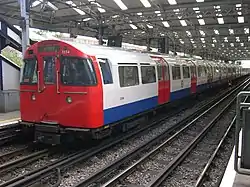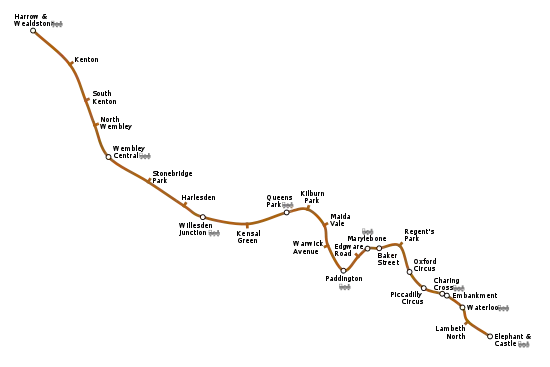Bakerloo line
The Baker Street & Waterloo line, otherwise known as simply the Baker & Waterloo line or Bakerloo line (/ˌbeɪkərˈluː/), is a line of the London Underground. It is coloured brown on the Tube map. It runs partly on the surface and partly at deep level, from Elephant & Castle in south-east to Wealdstone in north-west of London. The lines serves 25 stations of which 15 are underground. The line is around 14.4 miles (23.2 km) long.
| Bakerloo line | |
|---|---|
 A 1972 Stock Bakerloo Line train at Queen's Park Station | |
| Overview | |
| Stations | 25 |
| Colour on map | Brown |
| Website | tfl.gov.uk |
| Service | |
| Type | Rapid transit |
| System | London Underground |
| Depot(s) | Stonebridge Park London Road Queen's Park |
| Rolling stock | 1972 Tube Stock |
| Ridership | 111,136,000 (2011/12)[1] passenger journeys |
| History | |
| Opened | 10 March 1906 |
| Technical | |
| Line length | 23.2 km (14.4 mi) |
| Character | Deep level |
| Track gauge | 4 ft 8 1⁄2 in (1,435 mm) |
The line gets its name because it goes through the stations Baker Street tube station and Waterloo tube station. North of Queens Park, the line runs next to the West Coast Main Line.
Stations
| Bakerloo line | ||||||||||||||||||||||||||||||||||||||||||||||||||||||||||||||||||||||||||||||||||||||||||||||||||||||||||||||||||||||||||||||||||||||||||||||||||||||||||||||||||||||||||||||||||||||||||||||||||||||||||||||||||||||||||||||||||||||||||||||||||||||||||||||||||||||||||||||||||||||||||||||||||||||||||||||||||||||||||||||||||||||||||||||||||||||
|---|---|---|---|---|---|---|---|---|---|---|---|---|---|---|---|---|---|---|---|---|---|---|---|---|---|---|---|---|---|---|---|---|---|---|---|---|---|---|---|---|---|---|---|---|---|---|---|---|---|---|---|---|---|---|---|---|---|---|---|---|---|---|---|---|---|---|---|---|---|---|---|---|---|---|---|---|---|---|---|---|---|---|---|---|---|---|---|---|---|---|---|---|---|---|---|---|---|---|---|---|---|---|---|---|---|---|---|---|---|---|---|---|---|---|---|---|---|---|---|---|---|---|---|---|---|---|---|---|---|---|---|---|---|---|---|---|---|---|---|---|---|---|---|---|---|---|---|---|---|---|---|---|---|---|---|---|---|---|---|---|---|---|---|---|---|---|---|---|---|---|---|---|---|---|---|---|---|---|---|---|---|---|---|---|---|---|---|---|---|---|---|---|---|---|---|---|---|---|---|---|---|---|---|---|---|---|---|---|---|---|---|---|---|---|---|---|---|---|---|---|---|---|---|---|---|---|---|---|---|---|---|---|---|---|---|---|---|---|---|---|---|---|---|---|---|---|---|---|---|---|---|---|---|---|---|---|---|---|---|---|---|---|---|---|---|---|---|---|---|---|---|---|---|---|---|---|---|---|---|---|---|---|---|---|---|---|---|---|---|---|---|---|---|---|---|---|---|---|---|---|---|---|---|---|---|---|---|---|---|---|---|---|---|---|---|---|---|---|---|---|---|---|---|---|---|---|---|---|---|---|---|---|---|---|---|---|---|---|---|---|---|---|
| ||||||||||||||||||||||||||||||||||||||||||||||||||||||||||||||||||||||||||||||||||||||||||||||||||||||||||||||||||||||||||||||||||||||||||||||||||||||||||||||||||||||||||||||||||||||||||||||||||||||||||||||||||||||||||||||||||||||||||||||||||||||||||||||||||||||||||||||||||||||||||||||||||||||||||||||||||||||||||||||||||||||||||||||||||||||


Note: For the former Stanmore branch of the Bakerloo line, see the Jubilee line article.
| Station | Image | Opened | Additional Information |
|---|---|---|---|
| Harrow & Wealdstone | 16 April 1917 | Closed: 24 September 1982. Service restored: 4 June 1984 . | |
| Kenton | 16 April 1917 | Closed: 24 September 1982. Service restored: 4 June 1984. | |
| South Kenton | 3 July 1933 | Closed: 24 September 1982. Service restored: 4 June 1984. | |
| North Wembley | 16 April 1917 | Closed: 24 September 1982. Service restored: 4 June 1984. | |
| Wembley Central |  | 16 April 1917 | Opened as Wembley Central for Sudbury. Renamed: 5 July 1948. Closed: 24 September 1982. Service restored: 4 June 1984. |
| Stonebridge park | 1 August 1917 | ||
| Harlesden | 16 April 1917 | ||
| Willesden Junction | 10 May 1915 | ||
| Kensal Green | 1 October 1916 | ||
| Queen's Park | 11 February 1915 | ||
| Kilburn Park | 31 January 1915 | ||
| Maida Vale | 6 June 1915 | ||
| Warwick Avenue | 31 January 1915 | ||
| Paddington (Trains to Heathrow) | 1 December 1913 | ||
| Edgware Road |  | 15 June 1907 | |
| Marylebone | 27 March 1907 | Opened as Great Central. Renamed, 15 April 1917 | |
| Baker Street | 10 March 1906 | ||
| Regent's Park |  | 10 March 1906 | |
| Oxford Circus |  | 10 March 1906 | |
| Piccadilly Circus | 10 March 1906 | ||
| Charing Cross |  | 10 March 1906 | |
| Embankment | 10 March 1906 | ||
| Waterloo | 10 March 1906 | ||
| Lambeth North | 10 March 1906 | Opened as Kennington Road. Renamed Westminster Bridge Road: 5 August 1906, Renamed to Lambeth North: 15 April 1917 | |
| Elephant & Castle |  | 5 August 1906 |
Extension to Camberwell
The extension to Camberwell was a plan to extend the Bakerloo Line. The project was to start at the late 1940s, but they cancelled it for an unknown reason. Then in the 21st century, they revised the extension plan and proposed it again. So far, nothing has been agreed. The 1940s version of the extension had two stations. One rumour of why they cancelled the project was because Camberwell was quite a bad location to do further extensions.
Former Stations
Watford Branch
Between 1917 and 1982, Bakerloo line trains continued along the DC line past Harrow & Wealdstone to Watford Junction. These stations continue to be served by London Overground.
| Station | Opened | Closed | Additional Information |
|---|---|---|---|
| Watford Junction | 16 April 1917 | 16 September 1982 | |
| Watford High Street | 16 April 1917 | 24 September 1982 | |
| Bushey & Oxhey | 16 April 1917 | 24 September 1982 | Renamed Bushey: 6 May 1974 |
| Carpenders Park | 5 April 1919 | 24 September 1982 | Closed 16 November 1952. Re-opened on new site 17 November 1952 |
| Pinner & Hatch End | 16 April 1917 | 24 September 1982 | Renamed Hatch End (for Pinner): 1 February 1920. Renamed Hatch End: 1956. |
| Headstone Lane | 16 April 1917 | 24 September 1982 |
Stanmore branch
The Stanmore branch was originally constructed by the Metropolitan Railway (now the Metropolitan line) and was transferred to the Bakerloo line in 1939. It was transferred to the Jubilee line on 1 May 1979. It connected to the main line at Baker Street.
- Stanmore
- Canons Park
- Queensbury
- Kingsbury
- Wembley Park
- Neasden
- Dollis Hill
- Willesden Green
- Kilburn
- West Hampstead
- Finchley Road
- Swiss Cottage
- St. John's Wood
Map

The TFL line diagram Archived 2009-03-04 at the Wayback Machine is available online
References
- "LU Performance Data Almanac 2011/12". Transport for London. Archived from the original on 3 August 2012. Retrieved 1 August 2012.
- "Inter Station Database". Transport for London. 26 July 2006. Retrieved 1 March 2014.